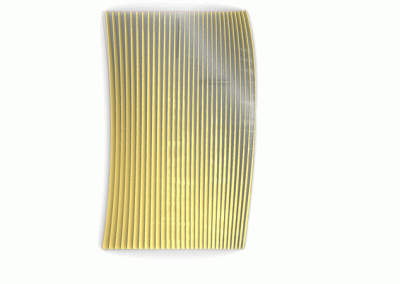Etmen Tabanlı Modelleme Araçlarıyla Yapıların Strüktürel Sistemlerinin Tasarlanması
Bu çalışma, kabuk yapılarda taşıyıcı sistemin etmen tabanlı modelleme (ETM) araçları kullanılarak tasarlanması ve oluşan sistemin strüktürel olarak analiz edilmesini sağlayan otomatize bir sistem oluşturmak hedeflemektedir. ETM araçları genellikle kentsel ölçekte yaya sirkülasyonu simülasyonu ve yoğunluk analizi, kritik koşullar altında tahliye simülasyonu gibi çalışmalara olanak tanıyan üretken tasarım araçlarıdır. Kullanım alanlarına bakıldığında farklı ölçeklerde, var olan ya da hedeflenen tasarımların analizi amacıyla kullanılmakta ve belirlenen koşullar dâhilinde önemli çıkarımlar yapılmasına olanak tanımaktadır. Çalışma kapsamında örnek senaryo olarak sera yapıları incelenmiş ve bu tip yapıların oluşturulmasında kullanılabilecek taşıyıcı sistemler üretilmiştir. Araştırma sonuçlarına göre genellikle tünel şeklinde bir kabuk olarak inşa edilen seralar, daha geniş bir alanı kaplamaları gerekmesi halinde yan yana birden fazla sera ya da gerekli noktalara taşıyıcılar ekleme şeklinde çözümler üretilerek yapılmaktadır. Klasikleşen bu çözüm yöntemleri, arzu edilen ya da hedeflenen tasarımı yapmak konusunda karşımıza bir engel olarak çıkmaktadır. Tüm bunların haricinde yapının gerekli analizleri yapılmadan entegre edilen bir taşıyıcı sistem bazı durumlarda fazladan malzeme ve maliyet, bazı durumlarda ise yapıda önemli bozulmalara yol açmaktadır. Tüm bunların sonucunda tasarımın henüz erken aşamasında oluşturulan bir taşıyıcı sistem, yaşanabilecek bu olumsuzlukların önüne geçmektedir. Kabuk yapıların taşıyıcı sistemlerinin, genel kullanım senaryolarından farklı olarak, etmenlerin hareketli yapılarından faydalanarak ETM araçları ile tasarlanması sistemin de otomatize edilmiş olma durumu göz önünde bulundurularak daha verimli ve etkin bir tasarım süreci sağlayacaktır. Çalışmada tanımlanması gereken değişkenler, tasarımcının kolaylıkla ifade edebileceği şekilde basitleştirilerek oluşturulmuş ve bu değişkenler yapının amacına uygun olarak tanımlandığı takdirde yapılan analizler doğrultusunda ideal sonuçlar sağlamaktadır. Bu bağlamda başlangıç aşamasında kabuk yapılara başarılır bir şekilde entegre edilen sistem, ileride daha karmaşık yapılara geçiş için ilk adımları oluşturacaktır.
Designing Structural Systems of Structures with Agent-Based Modeling Tools
This study aims to create an automated system that provides the design of the structural system in shell structures using agent-based modeling (ABM) tools and the structural analysis of the resulting system. ABM tools are generally generative design tools that allow studies such as urban scale pedestrian circulation simulation and density analysis, evacuation simulation under critical conditions. Considering the usage areas, it is used for the analysis of existing or targeted designs at different scales and allows important inferences to be made within the determined conditions. Within the scope of the study, greenhouse structures were examined as an example scenario and structural systems that could be used in the creation of such structures were produced. According to the results of the research, greenhouses, which are generally built as a tunnel-shaped shell, are made by producing more than one greenhouse next to each other or adding carriers to the necessary points if they need to cover a larger area. These conventional solution methods appear as an obstacle to making the desired or targeted design. Apart from all these, a load-bearing system that is integrated without the necessary analysis of the structure causes extra material and cost, and in some cases, significant deterioration in the structure. As a result, a structural system designed at an early stage of the design prevents these possible problems. Designing the structural systems of shell structures with ABM tools, making use of the mobility properties of the factors, unlike the general usage scenarios, will provide a more efficient and effective design process considering the automation of the system. The variables that need to be defined in the study are simplified so that the designer can easily express them, and if these variables are defined in accordance with the purpose of the building, they provide ideal results in line with the analyzes made. In this context, the system, which was successfully integrated into the shell structures at the initial stage, will constitute the first steps for the transition to more complex structures in the future.
© 2021 Istanbul Technical University Graduate School, Department of Informatics, Architectural Design Computing Program. All Rights Reserved
